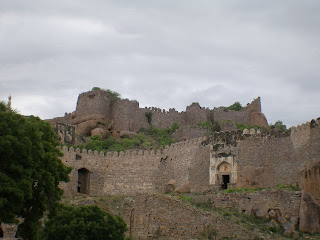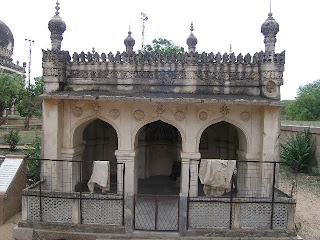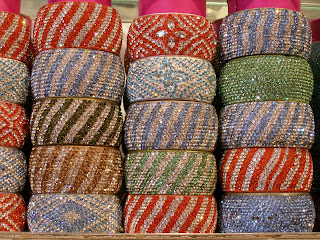In its most recent history, the region was ruled by the Kakatiyas and then the Bahmani sultans, the latter possibly of Tajik-Persian descent, and possibly the first Islamic and Shi'ite kingdom in South India. The Bahmani Sultanate, which broke away from the Delhi sultanate during the rule of Muhammad bin Tughluq in 1347, itself broke up into 5 states - the Deccan Sultanate in 1518. Golconda was one of these, rules by the Qutub Shahi dynasty. The grand Golconda fort was the power centre and a few miles away stand the beautiful Persian style Qutb Shahi Tombs.
The Golconda Fort walls and ruins
City from the Golconda Fort
Makkah Gate, Golconda Fort - The old Sultan used this gate to leave the Fort for the Hajj pilgrimage after abdicating the throne to his successor.
Hyderabad, according to popular lore, was established by Sultan Muhammad Quli Qutb Shah after he fell in love with Bhagyamati, a Hindu Banjara girl. After her acceptance into the royal fold, she was named Hyder Mahal, and thus the name Hyderabad. Another theory is that Hyderabad is the 'City of Hyder', named after Ali, the fourth Khalifah (Caliph) of Islam. The city was established on the banks of the Musi river in 1591. Today, the river is no more than a drain, but thankfully its cleaning and preservation work has started.
The Qutb Shahi Tombs are fine examples of carved stonework set in a large garden, and are a rare example of almost the entire dynasty buried in one area. An elaborate hamam, with great natural lighting, and reminiscent of the baths of Central Asia, is also within the precincts and was used to wash the dead before burial.
Tomb of Hayath Bakhshi Begum
The Mortuary Bath - built by Sultan Quli Qutb ul Mulk (1st king) along with his own tomb
Tomb of Sultan Muhammad Qutb Shah (6th king)
Tomb of Kulsoom Begum (daughter of Muhammad Qutb Shah)
Graves on the platform of Sultan Quli Qutb ul Mulk Tomb. In background are the Tomb of Kulsoom Begum and Muhammad Quli Qutb Shah
Tomb of Sultan Muhammad Qutb Shah (6th king)
Tomb of Sultan Muhammad Qutb Shah (4th king)
Aurangzeb's Masjid at the Qutb Shahi Tombs; Aurangzeb is said to have prayed here during the siege of Golconda in 1687
Golconda was finally captured by the Mughal king Aurangzeb in 1687 and was governed from Delhi through Governors, who in time gained autonomy. In 1724 Asaf Jah I, Nizamul Mulk (Governor of the country) established control over Hyderabad and the Asaf Jahi Dynasty. His descendents, the Nizams governed Hyderabad till 1948, when the State of Hyderabad joined the Union of India.
The Chowmahalla Palace of the Nizams is a neo-classical palace modeled on the Shah of Iran's Palace in Tehran. Its construction was started by Salabat Jung (4th in succession) in 1750 and was finally completed by the 5th Nizam, Asaf Jah V, in the period 1857-68. With elegant gardens and fountains, the palace has two courtyards - the northern courtyard housing the administration and the southern courtyard housing four palaces - Afzal Mahal, Aftab Mahal, Mehtab Mahal and Tahniyat Mahal. Its construction over a long period ensures a number of architectural styles. The jewel of the Palace is Khilwat Mubarak, the Durbar Hall of the Nizams.
Northern Courtyard, Chowmahalla Palace
Northern Courtyard
Khilwat Mubarak
Khilwat Clock; entrance to Chowmahalla Palace
Durbar Hall
The Throne
Entrance to the Southern Courtyard
Southern Courtyard
Palace details, Southern Courtyard
The old city of Hyderabad is crowded but a shopper's delight, with its pearl and saree shops and the Laad Bazaar with glittering shops selling shiny bangles, a Hyderabad trademark.
Laad Bazaar
Beautiful Hyderabadi Bangles
Two special buildings dominate the old city - the Charminar and the Makkah Masjid. Sultan Muhammad Quli Qutb Shah (5th Qutb Shahi king) built the Charminar after he shifted his capital from Golconda across the Musi River to Hyderabad. This is a monument of gratitude to Allah for sparing the city of the plague outbreak in 1591. It is actually a masjid (mosque), which is hidden on the upper floor, but the structure is dominated by four beautifully ornate, strong yet aesthetic minarets with exquisite carvings.
The Charminar
The Makkah Masjid, so called because Sultan Muhammad Qutb Shah (6th king) commissioned it using bricks made from earth brought from the Islamic city of Makkah (Mecca). The work began in 1617 and was finished 77 years later by Aurangzeb in 1694. Next to the masjid stands a simple but elegant structure that houses the graves of the Nizams.
Makkah Masjid (right) and the Mausoleum of the Nizams (left)
The lovely minarets of the Nizam mausoleum
Here rests the Asaf Jahi dynasty (the Nizams)
Pigeons are in plenty at the Makkah Masjid, with Charminar in background
Sultan Muhammad Quli Qutb Shah, a poet of great versatility and distinction in Persian and its forms later developed as the Urdu language, and in Dakhni (Southern Indian), dialect prayed at the inauguration of his new city.
Mera shehar logan soon mamoor kar
Rakhya joon tun darya mein min Ya Sami
(O God, fill my city with people, as you have the river with fish)
Rakhya joon tun darya mein min Ya Sami
(O God, fill my city with people, as you have the river with fish)
His wish seems to be granted. Hyderabad is teeming with people and more wanting to move there for the opportunities it offers today.
































